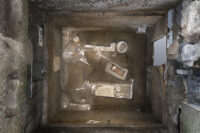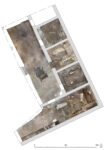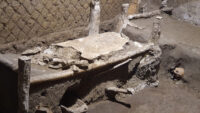 A small chamber used to store goods and sleep at least three people, almost certainly slaves, has been discovered in the excavation of a luxury villa in Civita Giuliana, a suburb of ancient Pompeii half a mile northwest of the city walls. The 170-square foot room has one tiny high window and opens onto the portico where the exceptional ceremonial chariot was discovered early this year parked in front of the room’s door, and is just one room over from the stall where the remains of Pompeii’s first confirmed horse were unearthed.
A small chamber used to store goods and sleep at least three people, almost certainly slaves, has been discovered in the excavation of a luxury villa in Civita Giuliana, a suburb of ancient Pompeii half a mile northwest of the city walls. The 170-square foot room has one tiny high window and opens onto the portico where the exceptional ceremonial chariot was discovered early this year parked in front of the room’s door, and is just one room over from the stall where the remains of Pompeii’s first confirmed horse were unearthed.
 Excavations at the villa began in 2017 in response to the discovery that looters had been tunneling into the ancient estate to plunder it of its treasures. The tunnels cause severe damage to the remains of two of the three equines found in the stall but thankfully disturbed the large horse the least so archaeologists were able to make a plaster cast of it.
Excavations at the villa began in 2017 in response to the discovery that looters had been tunneling into the ancient estate to plunder it of its treasures. The tunnels cause severe damage to the remains of two of the three equines found in the stall but thankfully disturbed the large horse the least so archaeologists were able to make a plaster cast of it.
The newly-discovered room is in excellent condition. Looters never reached it, and the team was able to make perfectly detailed casts of organic materials that left their imprint in the volcanic ash that covered the ancient  city. Casts were taken of three beds and a rudder shaft from a chariot that was leaning on one of the beds when it was immortalized by Vesuvius. Under the beds were chamber pots and other vessels that may have contained the meager personal effects of the persons who slept there. Near the beds was a wooden chest that held metal objects and fabrics believed to have been part of a horse harness. Eight large storage amphorae found in the corner of the room confirm that this space was used to keep gear and supplies as well as house three people.
city. Casts were taken of three beds and a rudder shaft from a chariot that was leaning on one of the beds when it was immortalized by Vesuvius. Under the beds were chamber pots and other vessels that may have contained the meager personal effects of the persons who slept there. Near the beds was a wooden chest that held metal objects and fabrics believed to have been part of a horse harness. Eight large storage amphorae found in the corner of the room confirm that this space was used to keep gear and supplies as well as house three people.
 The beds were made of rough-hewn wood planking with woven cord bases. The impression of the wood, the corded bed bases and even of the blankets on top of the beds have all been cast in plaster. The beds length could be adjusted for sleepers of different heights. Two of them are 1.7 meters (5’7″) long. The other is just 1.4 meters (4’7″) long, suggesting it was occupied by either a very petite adult or a child. It’s possible this tiny room was home for a family of three.
The beds were made of rough-hewn wood planking with woven cord bases. The impression of the wood, the corded bed bases and even of the blankets on top of the beds have all been cast in plaster. The beds length could be adjusted for sleepers of different heights. Two of them are 1.7 meters (5’7″) long. The other is just 1.4 meters (4’7″) long, suggesting it was occupied by either a very petite adult or a child. It’s possible this tiny room was home for a family of three.
“This is a window into the precarious reality of people who seldom appear in historical sources that were written almost exclusively by men belonging to the elite, and who as a result risk remaining invisible in the great historical accounts,” – declared Director General Gabriel Zuchtriegel – “It is a case in which archaeology helps us to discover a part of the ancient world which we would otherwise know little about, but which is nonetheless extremely important. What is most striking is the cramped and precarious nature of this room, which was something between a dormitory and a storage room of just 16 sqm, which we can now reconstruct thanks to the exceptional state of preservation created by the eruption of AD 79. It is certainly one of the most exciting discoveries during my life as an archaeologist, even without the presence of great ‘treasures’ – the true treasure here is the human experience, in this case of the most vulnerable members of ancient society, to which this room is a unique testimony.”



For Villa owners, that’s a classic: Where to store your slaves, and where the horsepowers :confused:
Interesting diamond pattern on the walls.
The Romans called that brick laying pattern “opus reticulatum” because it has a net like appearance.
Their descendants should seek reparations
Amazing that grown adults can’t see the difference between people enslaved so long ago that it is neither known who their descendants are, and that the trauma of enslavement is no longer carried by them with those who know their ancestors were recently enslaved and still carry the economic burdens of that unpaid labour in modern times.
But sure. It seems like a funny take if you avoid thinking about if for 3 seconds.
Maybe these assumptions about a family are based on more experience with the time period than I have but the first people that come to my mind are maybe a full time stable person, perhaps a part time apprentice and/or additional guest beds for visiting livery servants or whoever keeps an eye on a horse that may need medical intervention during the night and run to get the Doc. I wish we could learn the age and sex and story of these people.
The small one makes me think of my Grandpa working as a cow hand at 11 or 13 at the XIT ranch bc all the adults had gone to WWI.
Maybe these assumptions about a family are based on more experience with the time period than I have but the first people that come to my mind are maybe a full time stable person, perhaps a young part time apprentice and/or guest beds for visiting servants or a rider delivering something to the household or whoever keeps an eye on a horse that may need medical intervention during the night and run to get the Doc. I wish we could learn the age, sex and story of these people.
The small one makes me think of my Grandpa working as a cow hand at 11 or 13 at the XIT ranch bc all the adults had gone to WWI.